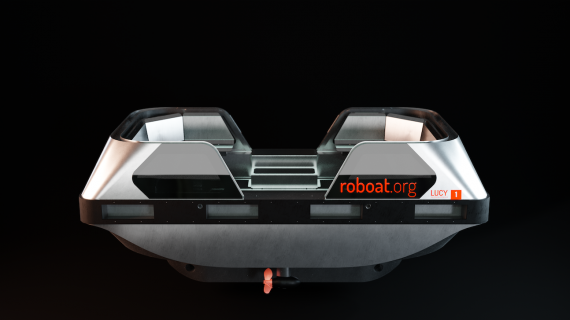What if autonomous boats could relieve Amsterdam's city center of heavy traffic over its vulnerable quays and bridges while making the canals a testbed for innovation?
Roboat – a research project by Massachusetts Institute of Technology (MIT) and Amsterdam Institute for Advanced Metropolitan Solutions (AMS Institute) – will provide self-driving solutions on water for different use cases. After successfully implementing full autonomy on the 1:4 and 1:2 scale boats, Roboat now introduces the first full-scale prototype – ready to start piloting real-life use cases.
Can't wait to see what the full-scale design looks like? Check out the video here.
The new 1:1 scale model
Roboat has a unique modular design. The vessel consists of a hull, that forms the technical basis of the boat, designed with different top-decks that can be applied for multiple use cases: transportation of people and garbage collection, as well as stages and bridges when latched together. The full-scale boat measures 2 by 4 meters. “These relatively small dimensions make the boat well suited for the urban environment,” says Carlo Ratti, Director of MIT Senseable City Lab and Principal Investigator in the project.
With four thrusters, the boat can move in all directions, making it agile and responsive to other traffic on the water, but also facilitating precise maneuvering for docking and latching.
“When individual Roboat units are latched, different combinations of floating platforms can be created. In their new configuration they form floating pixels and respond as new autonomous organisms” - Carlo Ratti | Professor at MIT Senseable City Lab & AMS PI
The full-scale Roboat is equipped with an improved perception sensor kit that combines LIDAR (Laser Image Detection and Ranging), GPS, DVL (Doppler Velocity Log) and camera-based object detection which enables the vessel to observe and scan the canals for path-finding and obstacle avoidance. When Roboat encounters an object in the water, the boat determines whether it is stationary or moving and measures the proximity and directionality of the object. The vessel then calculates the best maneuver to avoid the obstacle. After passing the obstacle, Roboat resumes its optimal route.
Pilots and experiments to develop use cases
In the coming months, the full-scale boat will be tested in the waters of Marineterrein Amsterdam Living Lab – a testbed for innovations and AMS Institute’s home base... Continue the full article here >>





